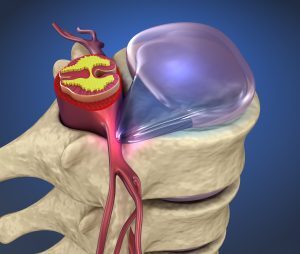Degenerated and Bulging Discs
What are the Characteristics of a Degenerated and Bulging Disc?

This is analogous to a tight rope fraying, becoming brittle, and weakening over time. A tight rope starts out strong, then gradually weakens as it weathers and more of its fibers break down. Eventually, a tight rope snaps. As the individual annular fibers of the disc "snap," the jelly-like nucleus oozes through it. The closer the Nucleus Pulposus approaches the outer perimeter of the Annulus Fibrosus, the more it starts to bulge and herniate at its weakest point. If the outer annular fibers break, the nucleus leaks out of the disc, which is a prolapsed disc. By the way, this process can take years or even decades to occur. It may be asymptomatic in the process, but when the disc compromises a nerve or the spinal cord, profound symptoms begin to surface.
A bulging disc can go either towards the right, left, or center. The direction in which the disc herniates will determine the symptoms. If a lumbar disc herniates to the left and pinches a nerve, the symptoms will affect the left leg. Conversely, if the disc herniates towards the right and entraps the nerve, the symptoms will affect the right leg. If the disc herniates in the center and closes down the spinal canal, then symptoms can occur in both legs simultaneously. On a side note, this same process applies to the neck and arms if disc herniations occur in the neck region.
-Dr. Randall Roth
